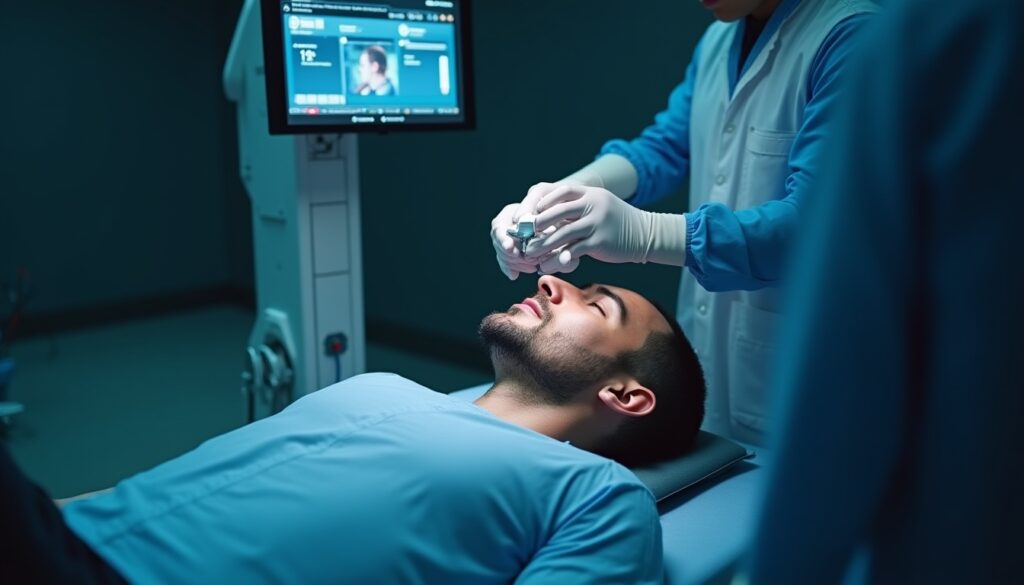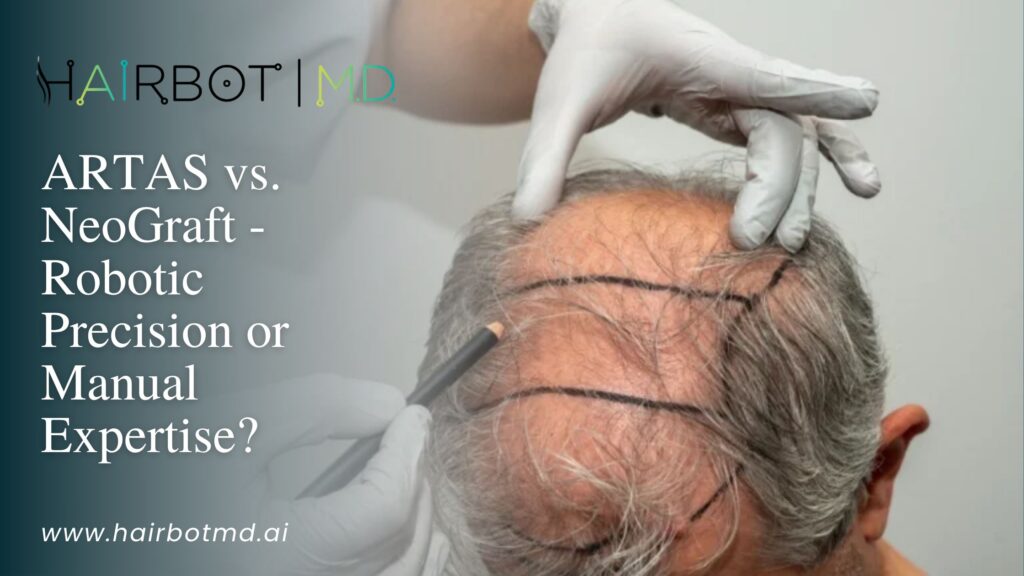ARTAS vs NeoGraft, two giants in hair restoration, marking a big shift in how tech’s changing follicle regrowth. People want more than just creams or pills now, and old-school transplants feel outdated.
We’re in a time where robotic smarts meet surgical skill, giving precision that once seemed impossible.
Hair loss hits deeper than looks, it shakes confidence, affects your career vibe, and messes with emotions. As more seek easy, effective fixes, picking the right method isn’t just a choice anymore; it’s a must.
The tech you pick shapes your hair’s density, how natural it looks, recovery speed, and transplant success for years ahead.
This makes ARTAS vs NeoGraft a crucial debate. One uses AI-driven robots for steady, precise harvesting; the other depends on expert hands with motorized tools.
So, which gives better results? Which is safer, smarter, and ready for the future?
This guide breaks down the science, pros, and cons of each helping you decide smartly to get back your hair and confidence with no regrets.
Understanding the Technology – ARTAS vs NeoGraft
Robotic Precision or Manual Expertise?
In the ARTAS vs NeoGraft debate, both systems use FUE (Follicular Unit Extraction), a modern hair restoration technique. FUE extracts individual follicular units, usually one to four hairs, directly from the scalp’s donor area.
This process avoids a linear scar, unlike traditional strip harvesting. It’s minimally invasive, faster to heal, and gives a natural hairline.
But here’s where it changes:
- ARTAS uses robotic precision with AI algorithms.
- NeoGraft applies surgeon-controlled pneumatic motors for manual extraction.
The ARTAS vs NeoGraft systems diverge in how they handle precision. ARTAS uses a robotic arm with stereoscopic vision and digital mapping. It chooses grafts based on angles, density, and direction no fatigue, just consistency.
NeoGraft uses a handheld punch tool with suction. Surgeons extract follicles manually with support from the motorized device. This gives more control, especially in tricky areas.
ARTAS does robotic dissection using blunt dual punches. That reduces follicular trauma. NeoGraft uses sharp rotary punches that cut faster but with slightly more risk.
In the ARTAS vs NeoGraft decision, tech-savvy patients lean toward automation. Others still trust skilled human hands. Each has strengths, and both can deliver dense, natural-looking results with the right surgeon.
How Each System Works: ARTAS vs NeoGraft Explained
ARTAS iX System – AI-guided, Robotic Follicle Harvesting
When comparing ARTAS vs NeoGraft, the ARTAS iX shines with advanced robotic automation. It uses high-definition stereoscopic vision to scan the scalp and analyze follicle patterns in 3D. This data fuels its AI-powered algorithms, helping it choose only the healthiest and most viable grafts.
- The robotic arm extracts follicles with dual-punch technology.
- AI ensures uniform spacing, avoiding overharvesting of donor zones.
- 3D mapping enables precise implantation site creation in real-time.
- No fatigue, no guesswork, and minimal tissue trauma.
It’s consistent. Smart. Accurate. The ARTAS vs NeoGraft comparison often tilts when tech matters more than touch.
NeoGraft System – Pneumatic-Assisted Manual Extraction
NeoGraft takes a more traditional route. It’s a manual motorized system enhanced with suction. Surgeons use a handheld punch tool, relying on their skill and stamina.
- Uses a motor-driven punch to isolate follicular units.
- Grafts are vacuum-extracted and then sorted by hand.
- Implantation is often manual, depending heavily on the technician.
- Human control offers flexibility, especially in complex scalp zones.
Precision here varies results depending on the technician’s expertise and consistency. In the ARTAS vs NeoGraft choice, this feels more artisanal, but also more variable.
Side-by-Side Comparison Table: ARTAS vs NeoGraft
| Feature | ARTAS iX | NeoGraft |
| Harvesting Technique | AI-Guided Robotic Extraction | Manual Motorized Extraction |
| Graft Selection | Algorithmic Selection of Optimal Follicles | Technician-Dependent |
| Scarring | No Linear Scars, Uniform Extraction | No Linear Scars, Variable Precision |
| Downtime | Minimal (Fast, Precise Harvesting) | Slightly Higher (Manual Technique) |
| Human Error | Near-Zero (Robot Never Tires) | Risk of Fatigue/Inconsistency |
| Hairline Design | 3D Simulation & AI Customization | Manual Mapping by Technician |
| Physician Involvement | High (Surgeon Oversees AI) | High (Technician-Centric Process) |
In ARTAS vs NeoGraft, the best choice comes down to values: precision or personalization.
Pros and Cons – ARTAS vs NeoGraft for Advanced Hair Restoration
ARTAS iX Pros – Robotic Reliability at Its Best
In the ARTAS vs NeoGraft battle, ARTAS iX offers serious robotic firepower. It’s built to perform consistently across all sessions.
- Uses AI-powered algorithms for precision harvesting.
- Significantly lower transaction rates (damaged grafts).
- Delivers uniform graft quality and natural spacing.
- Automated extraction removes human fatigue completely.
- Accelerated healing due to minimally invasive punches.
You get predictability, repeatability, and premium-quality graft yield. That’s a strong edge in the ARTAS vs NeoGraft debate.
ARTAS iX Cons: Smart Tech Has Limits Too
- Not great for curly or fibrous hair types robot struggles with angles.
- May not suit scarred or irregular donor areas well.
- Slightly higher upfront cost due to robotic sophistication.
Still, the consistency often offsets the price over time.
NeoGraft Pros: Manual Versatility
- Available in more clinics than ARTAS.
- Relies less on expensive tech infrastructure.
- Skilled techs can adjust extraction based on real-time scalp feedback.
When done right, NeoGraft shines especially for unique hair textures.
NeoGraft Cons: Inconsistency Risks
- Human fatigue leads to variable graft depth and quality.
- Results vary widely between clinics and techs.
- Lacks AI, so follicle selection isn’t optimized.
ARTAS vs NeoGraft, your outcome depends a lot more on who’s holding the tool than the tool itself.

The Science Behind Graft Survival & Aesthetic Success: ARTAS vs NeoGraft
In the ARTAS vs NeoGraft discussion, graft survival hinges on precise angle, depth, and density. These factors shape natural-looking results.
- Graft angle affects how hair grows out naturally; misalignment causes poor aesthetics.
- Extraction depth must be exact to avoid damaging follicles or causing unnecessary trauma.
- Density influences fullness; overharvesting weakens donor sites and underharvesting limits coverage.
ARTAS uses real-time 3D imaging and AI algorithms to continuously analyze and adjust these parameters. It precisely controls punch depth and angle for optimal graft viability. This robotic consistency reduces human error dramatically, giving surgeons reliable outcomes.
On the other hand, NeoGraft depends heavily on the technician’s experience and skill. Manual extraction means angle and depth vary from session to session, increasing risks of transection or poor graft survival. Consistency isn’t guaranteed without expert hands.
In the ARTAS vs NeoGraft comparison, this science-driven precision gives ARTAS a technical edge. It balances safety and aesthetics with automated control, minimizing risks while maximizing natural density. NeoGraft offers flexibility but leaves much up to human factors.
Choosing wisely means understanding these technical nuances. For those valuing predictable results and longevity, ARTAS often leads the way.
FAQ-Driven Insights: ARTAS vs NeoGraft
Which is better NeoGraft or ARTAS?
Most evidence leans toward ARTAS due to unmatched precision and consistent graft quality. NeoGraft relies more on technician skills, causing variable results.
What is the difference between NeoGraft and ARTAS?
ARTAS uses AI-guided robotics for automated follicle harvesting. NeoGraft employs motorized punches with manual control. Technology and outcome consistency separate them.
What is the most successful hair transplant?
FUE dominates modern hair restoration. ARTAS represents the next-gen FUE with robotic precision, improving survival and aesthetics beyond manual methods.
What makes a bad candidate for a hair transplant?
Poor donor density, scalp diseases, or uncontrolled medical conditions disqualify many. Robotic evaluation with ARTAS often better assesses candidacy precisely.
What are the cons of hair transplant?
Common issues include shock loss, infections, and graft failure. ARTAS’s robotic accuracy reduces these risks substantially.
What is better than a hair transplant?
Non-surgical options like PRP or topical treatments help only in early loss. For lasting results, robotic FUE with ARTAS remains the gold standard.
Which is the safest method of hair transplant?
ARTAS robotic FUE offers minimal invasiveness and precise graft harvesting, making it the safest choice in modern hair restoration technology.
Final Thoughts – Making the Right Choice About ARTAS vs NeoGraft
When you look at ARTAS vs NeoGraft, the differences hit you fast. ARTAS uses AI-powered robotics that automates follicle harvesting with crazy precision. It cuts down on human mistakes and keeps graft quality consistently top-notch. NeoGraft, meanwhile, leans a lot on the technician’s skill.
It’s manual, motorized extraction so results can swing depending on who’s doing it. Skilled hands? Great results. Less skilled? Not so much. ARTAS’s 3D scalp mapping and real-time AI? That’s next-level stuff, making it future-ready and perfect for folks wanting predictable, natural results with little downtime.
At HairBotMD, we fully back the ARTAS iX system for patients who want precision and long-lasting results. Dr. Sakina Broachwala, board-certified, delivers these treatments with top safety and care. The FDA-approved ARTAS iX blends advanced robotics with a personal touch right here in Cypress, Texas.
Patients often share stories of quick recovery, minimal scarring, and hairlines that look natural. This mix of tech and expert care gives outcomes you just don’t get with manual methods.
Picking between ARTAS and NeoGraft?
It’s really about robotic precision versus hands-on expertise. If you want consistency, safety, and cutting-edge science, ARTAS wins. Book a free assessment with HairBotMD now, and start your journey to a confident, natural look powered by robotic precision.
Redefine Hair Restoration – Advanced Robotic Transplant Solutions at HairBot MD
Step into the future of hair restoration with HairBot MD, your trusted destination for precision-driven robotic hair transplant technology. Our state-of-the-art platform combines cutting-edge robotics with expert medical oversight to deliver natural-looking results with unmatched accuracy and efficiency.
At HairBot MD, we specialize in robotic FUE transplants using systems like ARTAS®, offering minimally invasive procedures, faster recovery, and customized treatment planning. Whether you’re experiencing early-stage hair loss or seeking full restoration, our solutions are designed to meet your unique goals with confidence.
Explore our full range of services and discover how we blend science and artistry to deliver exceptional results. Visit our Home, learn more About our approach, or Contact us to speak with a specialist. Ready to take the first step? Get a Free Assessment today and start your journey to hair confidence.
📍 HairBot MD – Your Destination for Robotic Hair Transplant in Cypress, TX
Looking for the most advanced hair restoration solution near you? HairBot MD specializes in robotic hair transplants using the FDA-cleared ARTAS iX system, delivering precision, speed, and natural results.
✅ Address: 17110 House & Hahl Rd, B-2, Cypress, TX 77433
📞 Call Us: (346) 472-2353
✨ Claim Your Free HairBot MD Assessment!
Whether you’re curious about the ARTAS iX robotic system or ready to schedule a free consultation, our expert team is here to guide you through every step of your hair restoration journey.
